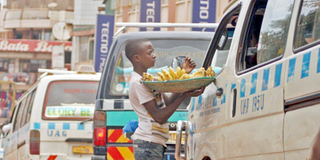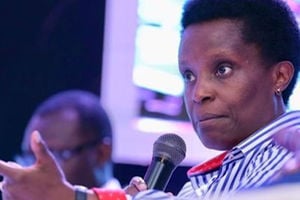Why poverty interventions remain ineffective

A young man sells bananas in Kampala. Uganda’s poverty eradication initiatves are yet to bear fruit. File photo
What you need to know:
The poverty problem
The major component of any poverty eradication programme therefore, should be helping the households to conceptualize the problem of poverty from their point of view, analyze its effects on their particular household and therefore suggest possible ways of attacking it using the resources at their disposal and the support programmes from government.
Many poverty stricken countries Uganda inclusive, have massively invested lots of dollars in fighting or eradicating poverty. Various programmes have been created and funded by governments to help eliminate poverty in these countries. In Uganda we have seen various schemes which include; the rural farmer’s scheme (1987), Entandikwa scheme (1996), the Poverty Eradication Action Plan (PEAP) with lots of programmes for the poor, the current Prosperity for All programme which was launched in 2006-07 etc.
Is there any positive effect of these programmes on the poor? The formative / Output evaluations will suggest a big YES to this question! Depending on how the evaluation is done and the objectives of the evaluation. However are the effects sustainable? Do they actually positively impact on the long term poverty situation in the rural and urban communities? May be not and that is why at the household level, poverty levels continue to be high despite the interventions.
I happen to be privileged to have both sociological and economics training which, I think has shaped me to think differently about poverty eradication. Also to note is that I am a victim of poverty myself and therefore I have experienced poverty with all my senses.
I have seen it, smelt it, felt it, heard it, tasted it, and therefore I don’t need to define poverty from the books which is the most case scenario by development planners and senior economists of our time! The definition of poverty according to me is not best what one has read in books and encyclopedias.
The best definition is what the poor will describe it because they understand poverty better. The understanding of poverty therefore will differ from household to household. Therefore, is it right to define poverty in general terms? Will this represent the varying understanding of poverty by the different households? Therefore do we think that the scholarly definitions of poverty are relevant to the practical poverty interventions in our countries today?
Where is the problem?
Many economists have approached the poverty problem at Macro level ignoring the Micro level. Of course most of them have no sociological training and therefore they don’t appreciate the social dimensions of poverty which are greatly rooted at the Micro level i.e. Household and community levels. This possibly in my opinion aggravates the problem and makes the interventions wanting!!!
You can not fight poverty with out understanding the problem with its core causes, and the only individual who understands poverty and its causes is the poor Individual or household. The household have experienced it in a unique way, they know the causes, the effects it has had on their lives and therefore possibly are in a better position to suggest the solutions to the problem given their condition. This is what makes the whole matter of poverty eradication complicated! The question is who is responsible for poverty eradication? Is it the government or the individual households?
My understanding is that, the poor household is solely responsible for poverty eradication and government only supplements the efforts of the household. I hope this doesn’t put a lot of confusion in the minds of those who have worked tirelessly for many years to fight poverty! This is because it is the house hold that understands the nature of poverty it faces, the causes of this kind of poverty, the intensity of effects of poverty on their lives and possibly how best they can remedy the situation. The economic planners at National and district level will only have an idea of what the nature of poverty and its effects are, being experienced by the households. Therefore the interventions proposed by the planners are not a complete cure to the problem. Possibly they act as pain killers!
Lack of this understanding and appreciation of this fact, is responsible for the ineffectiveness of the poverty eradication programmes in most of the developing countries. I am privileged to stay in India for 2 years since last year and have had an opportunity to visit many rural areas in the state of Uttar Pradesh, which is the biggest state in India with a population of close to 200 million people. Uttar Pradesh has a big number of poor Indians compared to other states implying that it has one of the highest poverty rates in India and Asia continent. I did try to compare these poor households with those of Uganda and my interest was to find out the effects of poverty eradication programmes on the poor households.
My observation of Indian rural households is that the Anti- poverty programmes in India since the 1st Five Year Plan 1950-1955 up to current plan have almost had no positive effect on the poor households. This is because the households are not at the core of the planning and therefore they only receive the programmes as beneficiaries.
They tend to think that Government has a lot of resources and therefore trying to spend these resources on them because they need votes from them during elections. The households have abused the benefits of these programmes by marrying other wives, preparing social parties, drinking alcohol using the funds, e.t.c. This scenario is not different from the scenario in Uganda. I remember, when Entandikwa scheme was launched, households did use the funds to marry 2nd and 3rd wives, organized weddings and many other social events using the funds.
The major problem is that the poor households have not been helped to analyze their poverty problem and its causes and therefore appreciate the need to work towards getting the solution or reducing its effects. The major component of any poverty eradication programme therefore, should be helping the households to conceptualize the problem of poverty from their point of view, analyze its effects on their particular household and therefore suggest possible ways of attacking it using the resources at their disposal and the support programmes from government. There is considerable evidence of some households that have graduated from being below the poverty line, to above it, with out the intervention of government. The household after analyzing the poverty problem comes up with a plan and implements it effectively which moves it from below poverty line to above the line.
What needs to be done?
There is a need to appreciate the fact that poverty eradication is a responsibility of the poor themselves and government programmes only supplements this cause. This means that any effective programme must approach the problem of poverty from the household level (micro level) and not Macro level. One of the best approaches is the method of community dialogue, where the community leaders, LCs, Religious leaders, and extension workers engage the households in a dialogue on poverty and how it affects their individual households. The households would then come up with action plans to fight the problem at household level and then reference can be given to them on the various support programmes that government has put in place.
Not until the households actually take the ball of eradicating the poverty in their own hands, Poverty eradication programmes and the huge investment in them, will never yield any results. The households can therefore ably make accountability of their actions and also demand the government support to improve their conditions. Otherwise currently they are supplied with such programmes with out demanding them from government. In economics, supply with out demand is a form of market failure!!!
The National planners and implementers of Poverty eradication programmes need to go back to the drawing table and correct this error, design poverty eradication programmes that are demand driven and therefore make the poor at the forefront of the planning process through community level dialogue and consultation. Sending a message of poverty eradication as a sole responsibility of the poor at all fora is the way to go.
I liked president Museveni’s regular talk on HIV/Aids prevention at every fora!! This technique can be adopted by all leaders at all levels during all fora. Then we will be assured of positive effects of the fight against poverty in our areas.
The writer is an Economics Scholar at University of Lucknow, India




